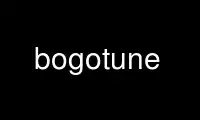
This is the command bogotune that can be run in the OnWorks free hosting provider using one of our multiple free online workstations such as Ubuntu Online, Fedora Online, Windows online emulator or MAC OS online emulator
PROGRAM:
NAME
bogotune - find optimum parameter settings for bogofilter
SYNOPSIS
bogotune [-v] [-c config] [-C] [-d dir] [-D] [-r value] [-T value]
-n okfile [[-n] okfile [...]] -s spamfile [[-s] spamfile [...]] [-M file]
bogotune [-h]
DESCRIPTION
Bogotune tries to find optimum parameter settings for bogofilter. It needs at least one
set each of spam and non-spam messages. The production wordlist is normally used, but it
can be directed to read a different wordlist, or to build its own from half the supplied
messages.
In order to produce useful results, bogotune has minimum message count requirements. The
wordlist it uses must have at least 2,000 spam and 2,000 non-spam in it and the message
files must contain at least 500 spam and 500 non-spam messages. Also, the ratio of spam to
non-spam should be in the range 0.2 to 5. If you direct bogotune to build its own
wordlist, it will use the half the input or 2000 messages (whichever is larger) for the
wordlist.
Message files may be in mbox, maildir, or MH folder or any combination. Msg-count files
can also be used, but not mixed with other formats.
OPTIONS
The -h option prints the help message and exits.
The -v option increases the verbosity level. Level 1 displays the scan output in detail
instead of using a progress meter.
The -c filename option tells bogofilter to read the config file named.
The -C option prevents bogotune from reading a configuration file.
The -d dir option specifies the directory for the database. See the ENVIRONMENT section
for other directory setting options.
The -D option tells bogotune to build a wordlist in memory using the input messages. The
messages are read and divided into two groups. The first group is used to build a wordlist
(in ram) and the second is used for tuning. To meet the minimum requirements of 2000
messages in the wordlist and 500 messages for testing, when -D is used, there must be 2500
non-spam and 2500 spam in the input files. If there are enough messages (more than 4000),
they will be split evenly between wordlist and testing. Otherwise, they will be split
proportionately.
The -n option tells bogotune that the following argument is a file (or folder) containing
non-spam. Since version 1.0.3, multiple arguments to the -n option can be given. All
non-option arguments until the next -s option will be treated as though they had been
preceded by -n
The -s option tells bogotune that the following argument is a file (or folder) containing
spam. It can be repeated as often as necessary. Since version 1.0.3, multiple arguments to
the -s can be given. All non-option arguments until the next -n option will be treated as
though they had been preceded by -s.
The -r value option tells bogotune to use the following parameter as the robx value.
The -T value option tells bogotune to use the following parameter as fp target value.
The -M file option tells bogotune to convert the file to message count format. This format
provides a sorted list of each message's unique tokens, along with their ham and spam
counts. Sorting hides the sense of the messages quite effectively, thus protecting
privacy. The message-count format allows bogotune and bogofilter to score messages quickly
without needing the original token database.
ENVIRONMENT
Bogofilter uses a database directory, which can be set in the config file. If not set
there, bogofilter will use the value of BOGOFILTER_DIR. Both can be overridden by the
-ddir option. If none of that is available, bogofilter will use directory
$HOME/.bogofilter.
Use bogotune online using onworks.net services
